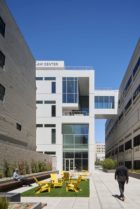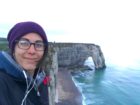
San Francisco-based architect Ammee Snyder doesn’t hesitate to tackle complex challenges, whether in her design work at SOM or in advocating for greater equity and representation throughout the industry. For this edition of “Spotlight,” a series on personal and professional journeys, Ammee shares what motivates and inspires her.

In the simplest terms, I enjoy solving problems through design. I like digging deep into new ways of thinking and I feel proud when I find a solution to a complex design problem. My work as an architect challenges me to do this every day.
I didn’t even know that I could draw until I was in architecture school. The year before I started college, my dad was building out the basement of our house. I got really excited about it — I was throwing out all sorts of ideas. I hadn’t decided yet what to study, and I said, I think I know what I’m going to do now.
So, I declared architecture as my major, started taking all of the Architecture 101 classes, started drawing… and I bombed. I felt like I was the worst in my drawing class. Everyone else could do shadows and lines and sculpt, while I was sitting there trying to draw a shoe that looked like a potato. I only managed to make one really good drawing. I guess I did a good job because my professor took it and showed it to the class. The funny thing is, to this day, I don’t know where that drawing is — I’m pretty sure she kept it to use as an example. But I wanted it as proof!
I worked at smaller firms in Utah before moving to San Francisco. When I decided to make a change, it was because I always felt that I could do more. I have big ideas about how architecture can improve the world, how it can help the environment — especially considering that the building industry is one of the biggest contributors to climate change. We have the opportunity to take on these big problems. Architects can’t do it alone, but we can champion it and bring other people to the table. I wanted more help, I needed more resources, more experience. I needed a bigger firm that has its arms and hands in everything.
When I started at SOM, it was a whole new world. The largest firm in Utah is about a hundred people — that’s the equivalent of one small office at SOM. When I got the opportunity, I was definitely ready to meet it. I tried to learn as much as I could as quickly as I could. I found myself improving workflows and solving problems, and started to really find my place here.
When a building is done, it’s the most incredible feeling. You’ve been staring at these drawings for years and then, all of a sudden, you’re walking in the hallways that you drew.
My first project at SOM was the new building for UC Hastings Law in downtown San Francisco. I was a part of that team starting from the end of design development all the way through overseeing the construction. It was a two-year endeavor, it was a design-build project, and it was very challenging. Now that it’s complete, what makes me really proud is that we’ve showcased it a lot. And we met our sustainability goal: the building is certified LEED Platinum. That was really exciting for me — being thrown into a difficult project, and seeing it through to a positive outcome.


What really made the UC Hastings project successful was the team — we just really connected. I found a mentor who was able to bring me up to speed and up to par really quickly. We had architects, structural engineers, graphic designers all working together. Everybody was just committed to seeing this succeed.
The first time you work on a building, when it’s done, it’s the most incredible feeling. You’ve been staring at these drawings for years and then, all of a sudden, you’re walking in the hallways that you drew. No matter how many projects I’ve completed, that feeling never gets old. It’s what keeps me going.

Trying to champion betterment for myself or other people in the office is something that I naturally lean toward. When I started at SOM, I asked point-blank about the culture of the firm and if they would be OK with things I wanted to do, things that I cared about.
Within the firm, I’ve been active in communities such as SOM Pride and the Women’s Initiative. I’m involved with NOMA’s Project Pipeline — we teach about architecture in summer camps, working with kids who are primarily Black, Indigenous, and people of color. We’re trying to reach communities that are underrepresented in the design field, to accelerate change in our industry.
Representation matters. It’s important to see other people like you who are celebrated and appreciated. I like the idea of being a role model, if someone sees me as that. Whether it’s for young kids who identify as women, or if they’re gay or questioning — if they identify with me in some way, and see that I’m being appreciated and validated, as an architect, or as a professional, or just as a happy person, that’s a good thing. It’s important for them to have that exposure, to see that other people are able to navigate the world in a positive way.
I gave a presentation for the whole San Francisco office, together with a few other women, on the difference between equality, equity and justice. This was when the #MeToo movement was starting to happen. It was before the Black Lives Matter protests grew in 2020 into the most powerful social justice movement we’ve seen in our lifetimes, but that conversation was already arising, adjacent to #MeToo, about the difference between equality and equity, and how that relates to justice. It might seem basic, but we thought that this was an important concept to know. After our presentation a lot of people said, now I get it. And that was the whole point.
I started a conversation at SOM about pronouns a couple of years ago. I noticed, for instance, that the HR system that we used at the time only had options for male or female. I didn’t find this to be inclusive, and asked if it was a simple change that we could make.

Then I wondered if we could take this further: if we could add pronouns to our email signatures. After running the idea by a few colleagues, I decided to just do it — I put my pronouns in my signature. I like to push people a little bit. It’s not to make them uncomfortable, it’s just to advocate that it is OK to talk about these issues. Now it’s taken on its own life. Other people at SOM have adopted this. And the SOM Pride group is working with leadership on a comprehensive project around pronouns and inclusivity, which is great.
While I’ve had some successes working to change the culture in our industry, there’s still a lot of room to improve. I don’t always remember to state my gender pronouns when I introduce myself in meetings. But I should. There’s safety in privilege, and doing this in a business or professional setting is very rare. Being the person to start it will help get other people to feel like it’s OK.